Leadership Practices: Enactment in Today's Messy Organizations
VerifiedAdded on 2023/06/14
|11
|3104
|330
Essay
AI Summary
This essay provides an overview of leadership enactment in today's complex business world, drawing insights from several articles. It discusses various approaches to leadership, including dynamic, collective, situational, and dialectic perspectives, and highlights the importance of relational competencies. The essay also explores the role of embodiment and narcissism in leadership, emphasizing the shift towards more collaborative and less hierarchical organizational structures in the 21st century. The analysis covers the need for leaders to adapt to ambiguity, complexity, and rapid decision-making in a global context, advocating for shared visions and the use of visual metaphors to convey complex situations. The essay concludes by stressing the importance of inventiveness in dealing with the intense dichotomies of leadership in the modern era.
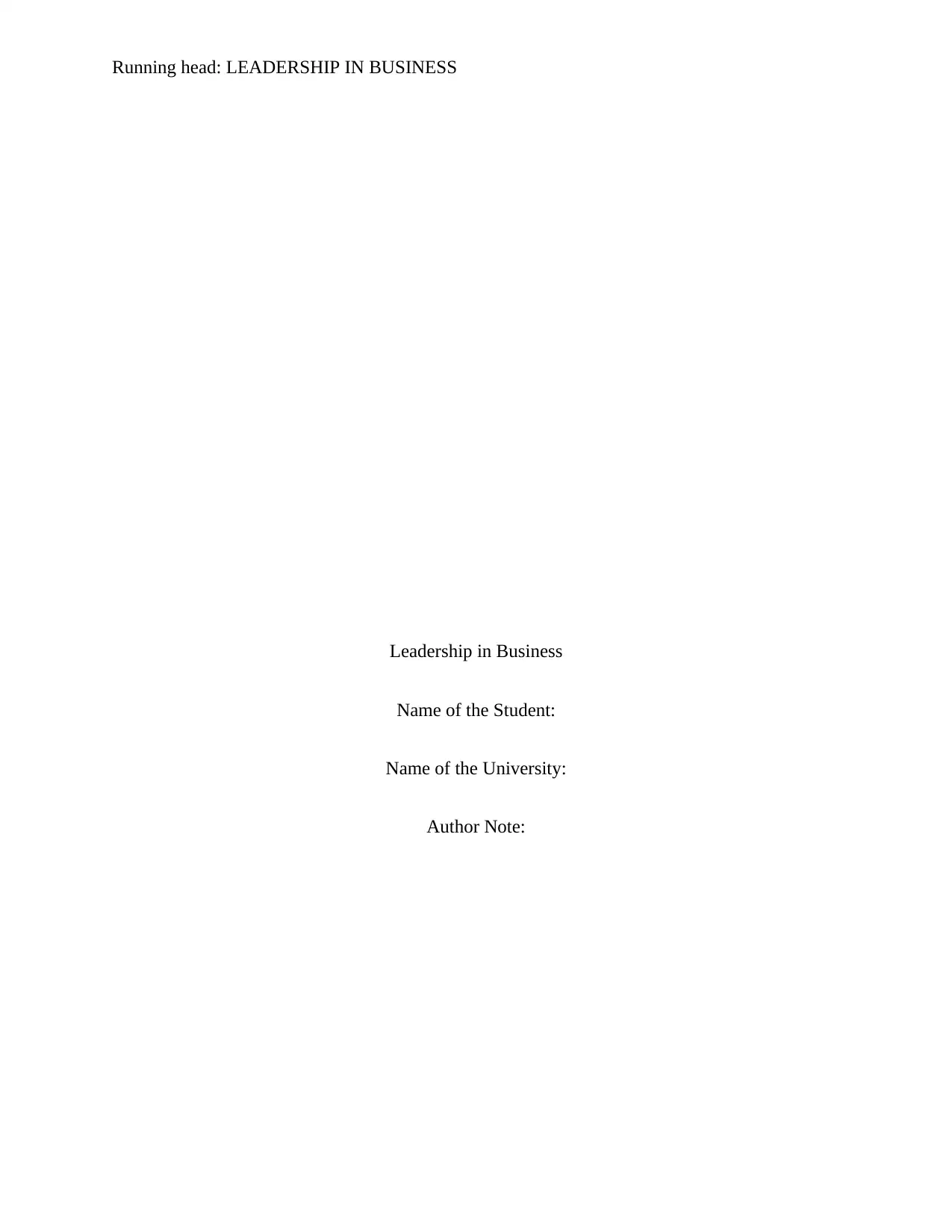
Running head: LEADERSHIP IN BUSINESS
Leadership in Business
Name of the Student:
Name of the University:
Author Note:
Leadership in Business
Name of the Student:
Name of the University:
Author Note:
Paraphrase This Document
Need a fresh take? Get an instant paraphrase of this document with our AI Paraphraser
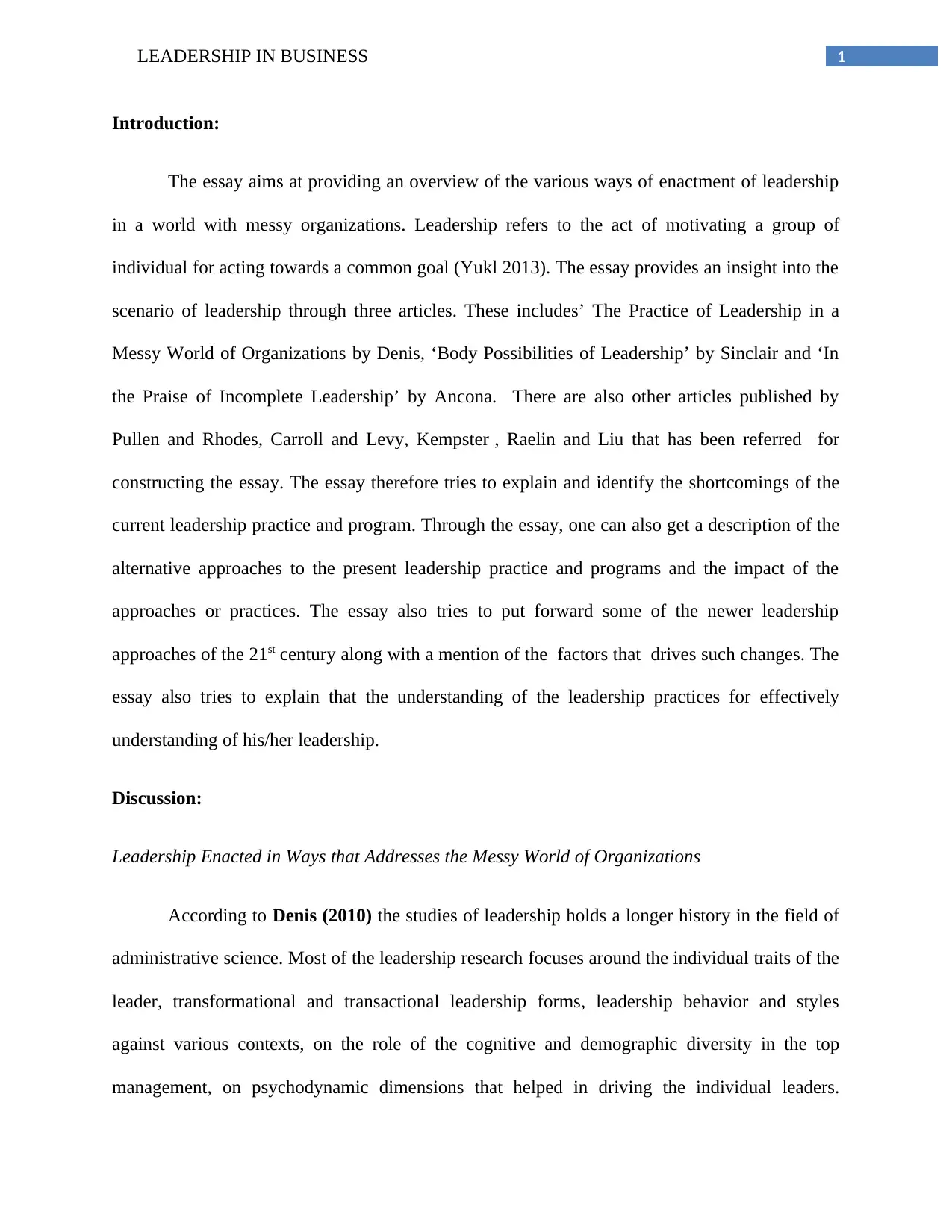
1LEADERSHIP IN BUSINESS
Introduction:
The essay aims at providing an overview of the various ways of enactment of leadership
in a world with messy organizations. Leadership refers to the act of motivating a group of
individual for acting towards a common goal (Yukl 2013). The essay provides an insight into the
scenario of leadership through three articles. These includes’ The Practice of Leadership in a
Messy World of Organizations by Denis, ‘Body Possibilities of Leadership’ by Sinclair and ‘In
the Praise of Incomplete Leadership’ by Ancona. There are also other articles published by
Pullen and Rhodes, Carroll and Levy, Kempster , Raelin and Liu that has been referred for
constructing the essay. The essay therefore tries to explain and identify the shortcomings of the
current leadership practice and program. Through the essay, one can also get a description of the
alternative approaches to the present leadership practice and programs and the impact of the
approaches or practices. The essay also tries to put forward some of the newer leadership
approaches of the 21st century along with a mention of the factors that drives such changes. The
essay also tries to explain that the understanding of the leadership practices for effectively
understanding of his/her leadership.
Discussion:
Leadership Enacted in Ways that Addresses the Messy World of Organizations
According to Denis (2010) the studies of leadership holds a longer history in the field of
administrative science. Most of the leadership research focuses around the individual traits of the
leader, transformational and transactional leadership forms, leadership behavior and styles
against various contexts, on the role of the cognitive and demographic diversity in the top
management, on psychodynamic dimensions that helped in driving the individual leaders.
Introduction:
The essay aims at providing an overview of the various ways of enactment of leadership
in a world with messy organizations. Leadership refers to the act of motivating a group of
individual for acting towards a common goal (Yukl 2013). The essay provides an insight into the
scenario of leadership through three articles. These includes’ The Practice of Leadership in a
Messy World of Organizations by Denis, ‘Body Possibilities of Leadership’ by Sinclair and ‘In
the Praise of Incomplete Leadership’ by Ancona. There are also other articles published by
Pullen and Rhodes, Carroll and Levy, Kempster , Raelin and Liu that has been referred for
constructing the essay. The essay therefore tries to explain and identify the shortcomings of the
current leadership practice and program. Through the essay, one can also get a description of the
alternative approaches to the present leadership practice and programs and the impact of the
approaches or practices. The essay also tries to put forward some of the newer leadership
approaches of the 21st century along with a mention of the factors that drives such changes. The
essay also tries to explain that the understanding of the leadership practices for effectively
understanding of his/her leadership.
Discussion:
Leadership Enacted in Ways that Addresses the Messy World of Organizations
According to Denis (2010) the studies of leadership holds a longer history in the field of
administrative science. Most of the leadership research focuses around the individual traits of the
leader, transformational and transactional leadership forms, leadership behavior and styles
against various contexts, on the role of the cognitive and demographic diversity in the top
management, on psychodynamic dimensions that helped in driving the individual leaders.
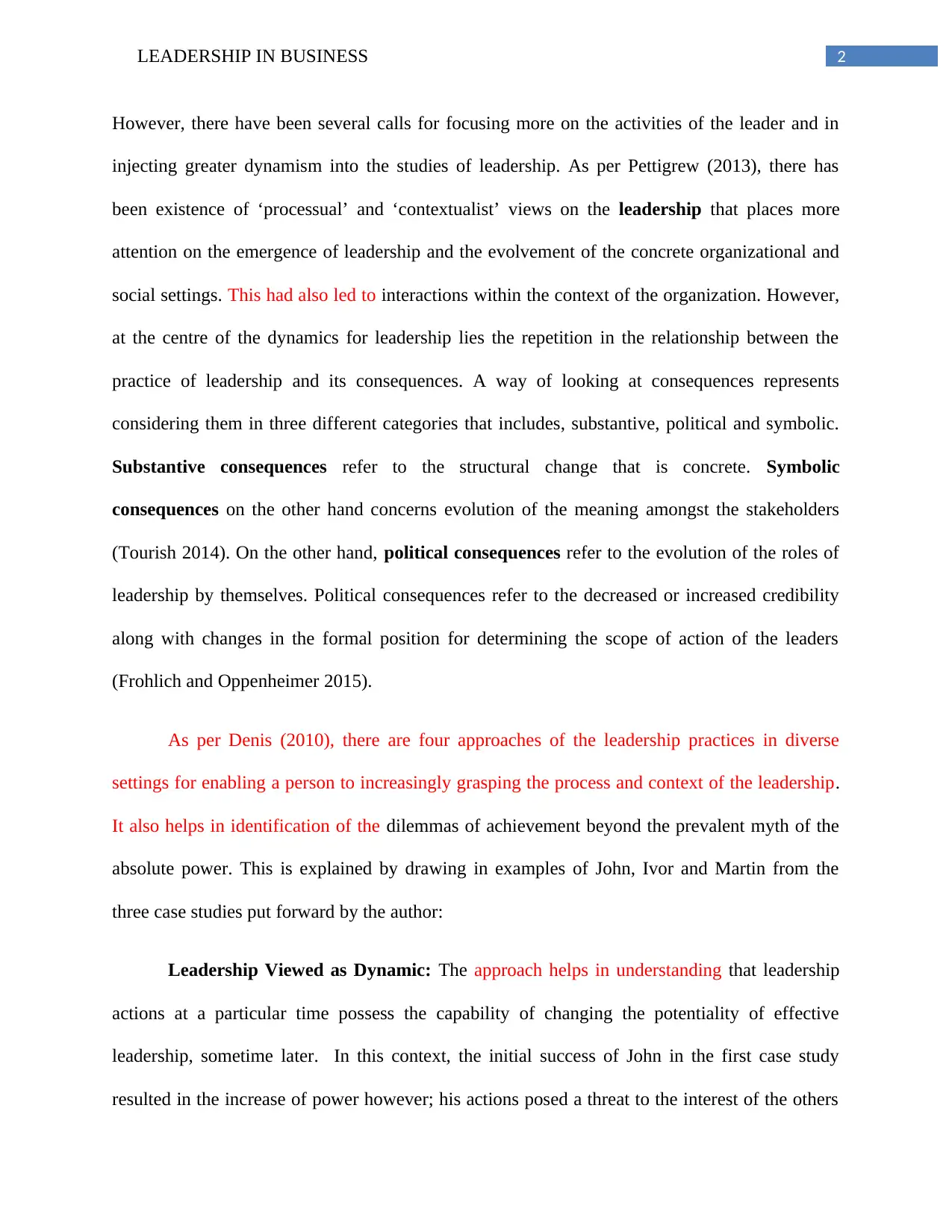
2LEADERSHIP IN BUSINESS
However, there have been several calls for focusing more on the activities of the leader and in
injecting greater dynamism into the studies of leadership. As per Pettigrew (2013), there has
been existence of ‘processual’ and ‘contextualist’ views on the leadership that places more
attention on the emergence of leadership and the evolvement of the concrete organizational and
social settings. This had also led to interactions within the context of the organization. However,
at the centre of the dynamics for leadership lies the repetition in the relationship between the
practice of leadership and its consequences. A way of looking at consequences represents
considering them in three different categories that includes, substantive, political and symbolic.
Substantive consequences refer to the structural change that is concrete. Symbolic
consequences on the other hand concerns evolution of the meaning amongst the stakeholders
(Tourish 2014). On the other hand, political consequences refer to the evolution of the roles of
leadership by themselves. Political consequences refer to the decreased or increased credibility
along with changes in the formal position for determining the scope of action of the leaders
(Frohlich and Oppenheimer 2015).
As per Denis (2010), there are four approaches of the leadership practices in diverse
settings for enabling a person to increasingly grasping the process and context of the leadership.
It also helps in identification of the dilemmas of achievement beyond the prevalent myth of the
absolute power. This is explained by drawing in examples of John, Ivor and Martin from the
three case studies put forward by the author:
Leadership Viewed as Dynamic: The approach helps in understanding that leadership
actions at a particular time possess the capability of changing the potentiality of effective
leadership, sometime later. In this context, the initial success of John in the first case study
resulted in the increase of power however; his actions posed a threat to the interest of the others
However, there have been several calls for focusing more on the activities of the leader and in
injecting greater dynamism into the studies of leadership. As per Pettigrew (2013), there has
been existence of ‘processual’ and ‘contextualist’ views on the leadership that places more
attention on the emergence of leadership and the evolvement of the concrete organizational and
social settings. This had also led to interactions within the context of the organization. However,
at the centre of the dynamics for leadership lies the repetition in the relationship between the
practice of leadership and its consequences. A way of looking at consequences represents
considering them in three different categories that includes, substantive, political and symbolic.
Substantive consequences refer to the structural change that is concrete. Symbolic
consequences on the other hand concerns evolution of the meaning amongst the stakeholders
(Tourish 2014). On the other hand, political consequences refer to the evolution of the roles of
leadership by themselves. Political consequences refer to the decreased or increased credibility
along with changes in the formal position for determining the scope of action of the leaders
(Frohlich and Oppenheimer 2015).
As per Denis (2010), there are four approaches of the leadership practices in diverse
settings for enabling a person to increasingly grasping the process and context of the leadership.
It also helps in identification of the dilemmas of achievement beyond the prevalent myth of the
absolute power. This is explained by drawing in examples of John, Ivor and Martin from the
three case studies put forward by the author:
Leadership Viewed as Dynamic: The approach helps in understanding that leadership
actions at a particular time possess the capability of changing the potentiality of effective
leadership, sometime later. In this context, the initial success of John in the first case study
resulted in the increase of power however; his actions posed a threat to the interest of the others
⊘ This is a preview!⊘
Do you want full access?
Subscribe today to unlock all pages.

Trusted by 1+ million students worldwide
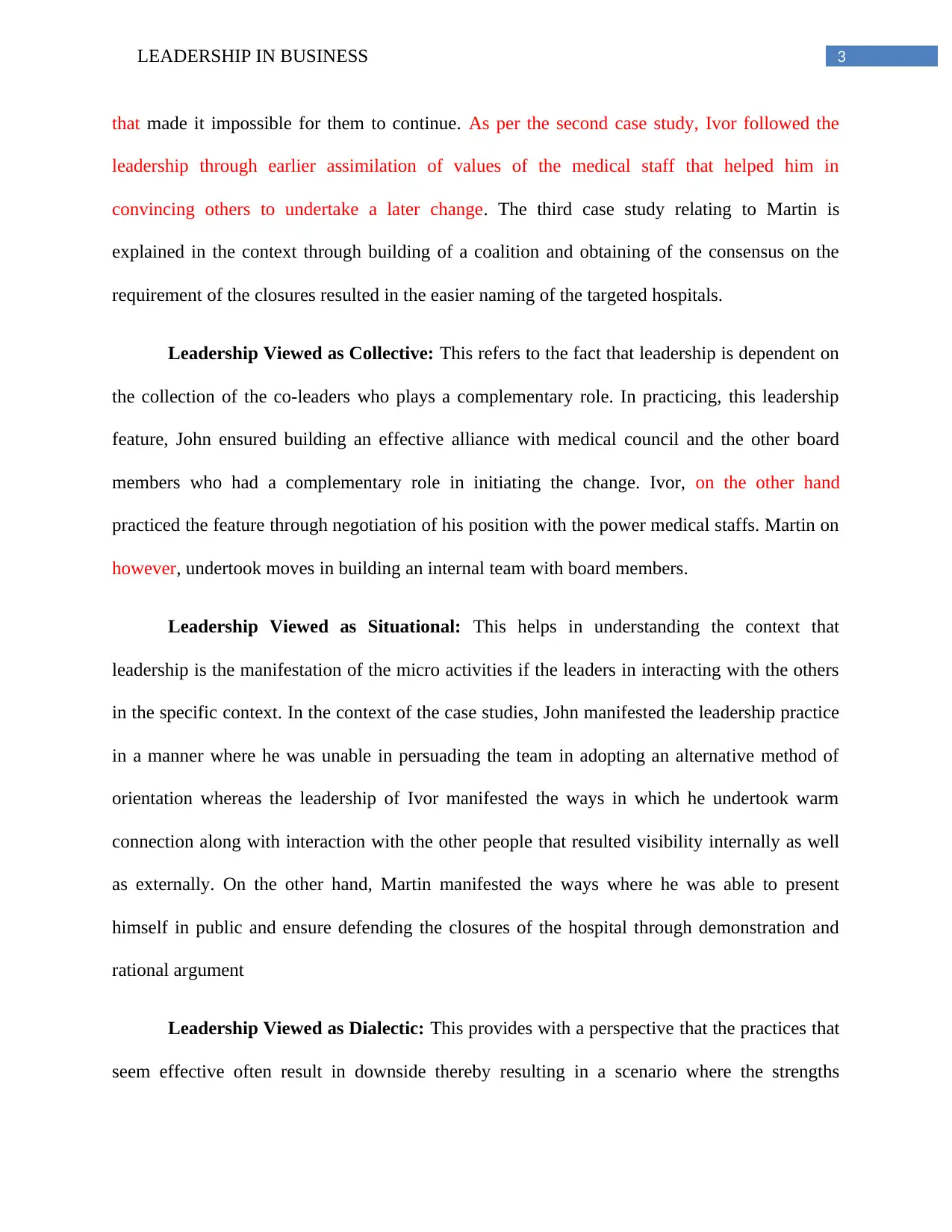
3LEADERSHIP IN BUSINESS
that made it impossible for them to continue. As per the second case study, Ivor followed the
leadership through earlier assimilation of values of the medical staff that helped him in
convincing others to undertake a later change. The third case study relating to Martin is
explained in the context through building of a coalition and obtaining of the consensus on the
requirement of the closures resulted in the easier naming of the targeted hospitals.
Leadership Viewed as Collective: This refers to the fact that leadership is dependent on
the collection of the co-leaders who plays a complementary role. In practicing, this leadership
feature, John ensured building an effective alliance with medical council and the other board
members who had a complementary role in initiating the change. Ivor, on the other hand
practiced the feature through negotiation of his position with the power medical staffs. Martin on
however, undertook moves in building an internal team with board members.
Leadership Viewed as Situational: This helps in understanding the context that
leadership is the manifestation of the micro activities if the leaders in interacting with the others
in the specific context. In the context of the case studies, John manifested the leadership practice
in a manner where he was unable in persuading the team in adopting an alternative method of
orientation whereas the leadership of Ivor manifested the ways in which he undertook warm
connection along with interaction with the other people that resulted visibility internally as well
as externally. On the other hand, Martin manifested the ways where he was able to present
himself in public and ensure defending the closures of the hospital through demonstration and
rational argument
Leadership Viewed as Dialectic: This provides with a perspective that the practices that
seem effective often result in downside thereby resulting in a scenario where the strengths
that made it impossible for them to continue. As per the second case study, Ivor followed the
leadership through earlier assimilation of values of the medical staff that helped him in
convincing others to undertake a later change. The third case study relating to Martin is
explained in the context through building of a coalition and obtaining of the consensus on the
requirement of the closures resulted in the easier naming of the targeted hospitals.
Leadership Viewed as Collective: This refers to the fact that leadership is dependent on
the collection of the co-leaders who plays a complementary role. In practicing, this leadership
feature, John ensured building an effective alliance with medical council and the other board
members who had a complementary role in initiating the change. Ivor, on the other hand
practiced the feature through negotiation of his position with the power medical staffs. Martin on
however, undertook moves in building an internal team with board members.
Leadership Viewed as Situational: This helps in understanding the context that
leadership is the manifestation of the micro activities if the leaders in interacting with the others
in the specific context. In the context of the case studies, John manifested the leadership practice
in a manner where he was unable in persuading the team in adopting an alternative method of
orientation whereas the leadership of Ivor manifested the ways in which he undertook warm
connection along with interaction with the other people that resulted visibility internally as well
as externally. On the other hand, Martin manifested the ways where he was able to present
himself in public and ensure defending the closures of the hospital through demonstration and
rational argument
Leadership Viewed as Dialectic: This provides with a perspective that the practices that
seem effective often result in downside thereby resulting in a scenario where the strengths
Paraphrase This Document
Need a fresh take? Get an instant paraphrase of this document with our AI Paraphraser
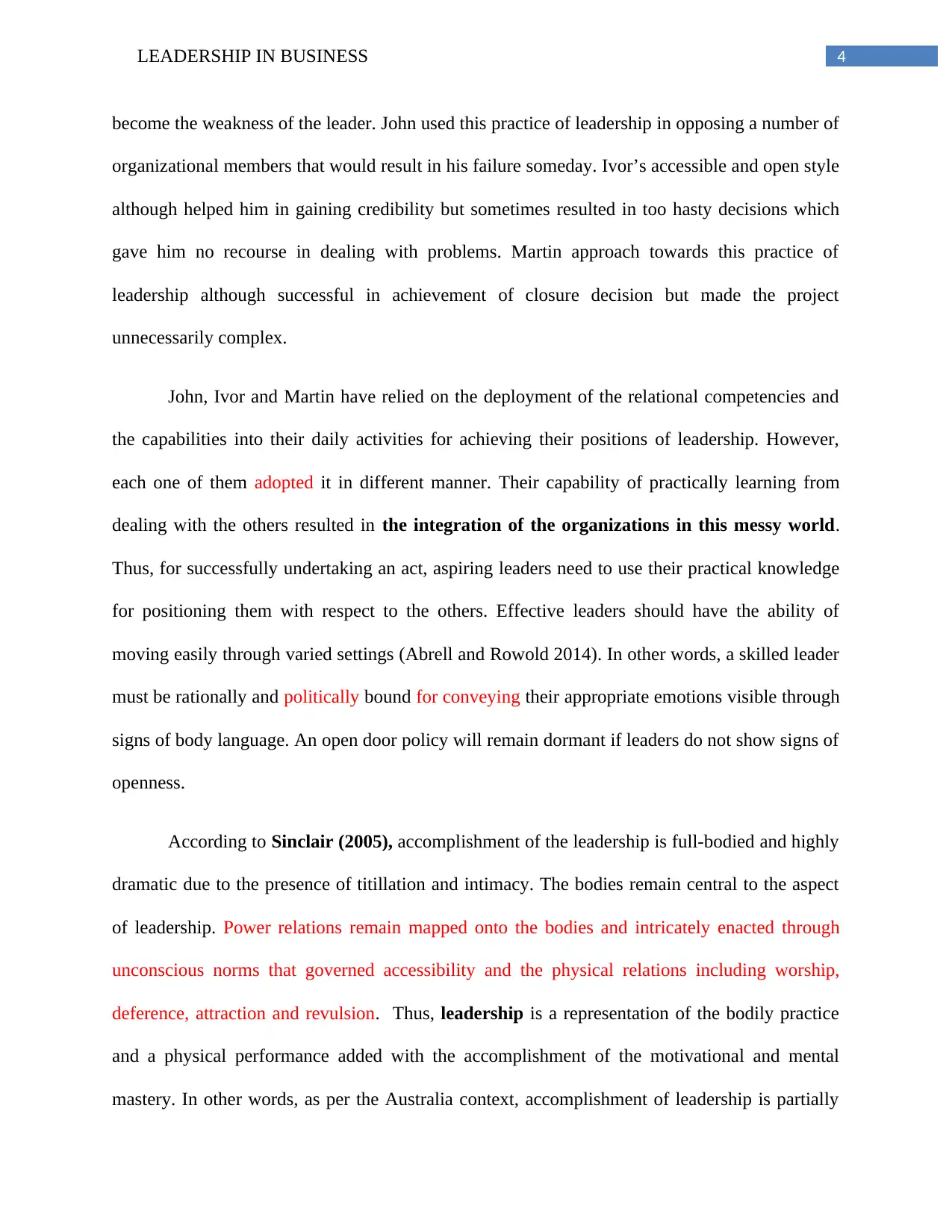
4LEADERSHIP IN BUSINESS
become the weakness of the leader. John used this practice of leadership in opposing a number of
organizational members that would result in his failure someday. Ivor’s accessible and open style
although helped him in gaining credibility but sometimes resulted in too hasty decisions which
gave him no recourse in dealing with problems. Martin approach towards this practice of
leadership although successful in achievement of closure decision but made the project
unnecessarily complex.
John, Ivor and Martin have relied on the deployment of the relational competencies and
the capabilities into their daily activities for achieving their positions of leadership. However,
each one of them adopted it in different manner. Their capability of practically learning from
dealing with the others resulted in the integration of the organizations in this messy world.
Thus, for successfully undertaking an act, aspiring leaders need to use their practical knowledge
for positioning them with respect to the others. Effective leaders should have the ability of
moving easily through varied settings (Abrell and Rowold 2014). In other words, a skilled leader
must be rationally and politically bound for conveying their appropriate emotions visible through
signs of body language. An open door policy will remain dormant if leaders do not show signs of
openness.
According to Sinclair (2005), accomplishment of the leadership is full-bodied and highly
dramatic due to the presence of titillation and intimacy. The bodies remain central to the aspect
of leadership. Power relations remain mapped onto the bodies and intricately enacted through
unconscious norms that governed accessibility and the physical relations including worship,
deference, attraction and revulsion. Thus, leadership is a representation of the bodily practice
and a physical performance added with the accomplishment of the motivational and mental
mastery. In other words, as per the Australia context, accomplishment of leadership is partially
become the weakness of the leader. John used this practice of leadership in opposing a number of
organizational members that would result in his failure someday. Ivor’s accessible and open style
although helped him in gaining credibility but sometimes resulted in too hasty decisions which
gave him no recourse in dealing with problems. Martin approach towards this practice of
leadership although successful in achievement of closure decision but made the project
unnecessarily complex.
John, Ivor and Martin have relied on the deployment of the relational competencies and
the capabilities into their daily activities for achieving their positions of leadership. However,
each one of them adopted it in different manner. Their capability of practically learning from
dealing with the others resulted in the integration of the organizations in this messy world.
Thus, for successfully undertaking an act, aspiring leaders need to use their practical knowledge
for positioning them with respect to the others. Effective leaders should have the ability of
moving easily through varied settings (Abrell and Rowold 2014). In other words, a skilled leader
must be rationally and politically bound for conveying their appropriate emotions visible through
signs of body language. An open door policy will remain dormant if leaders do not show signs of
openness.
According to Sinclair (2005), accomplishment of the leadership is full-bodied and highly
dramatic due to the presence of titillation and intimacy. The bodies remain central to the aspect
of leadership. Power relations remain mapped onto the bodies and intricately enacted through
unconscious norms that governed accessibility and the physical relations including worship,
deference, attraction and revulsion. Thus, leadership is a representation of the bodily practice
and a physical performance added with the accomplishment of the motivational and mental
mastery. In other words, as per the Australia context, accomplishment of leadership is partially
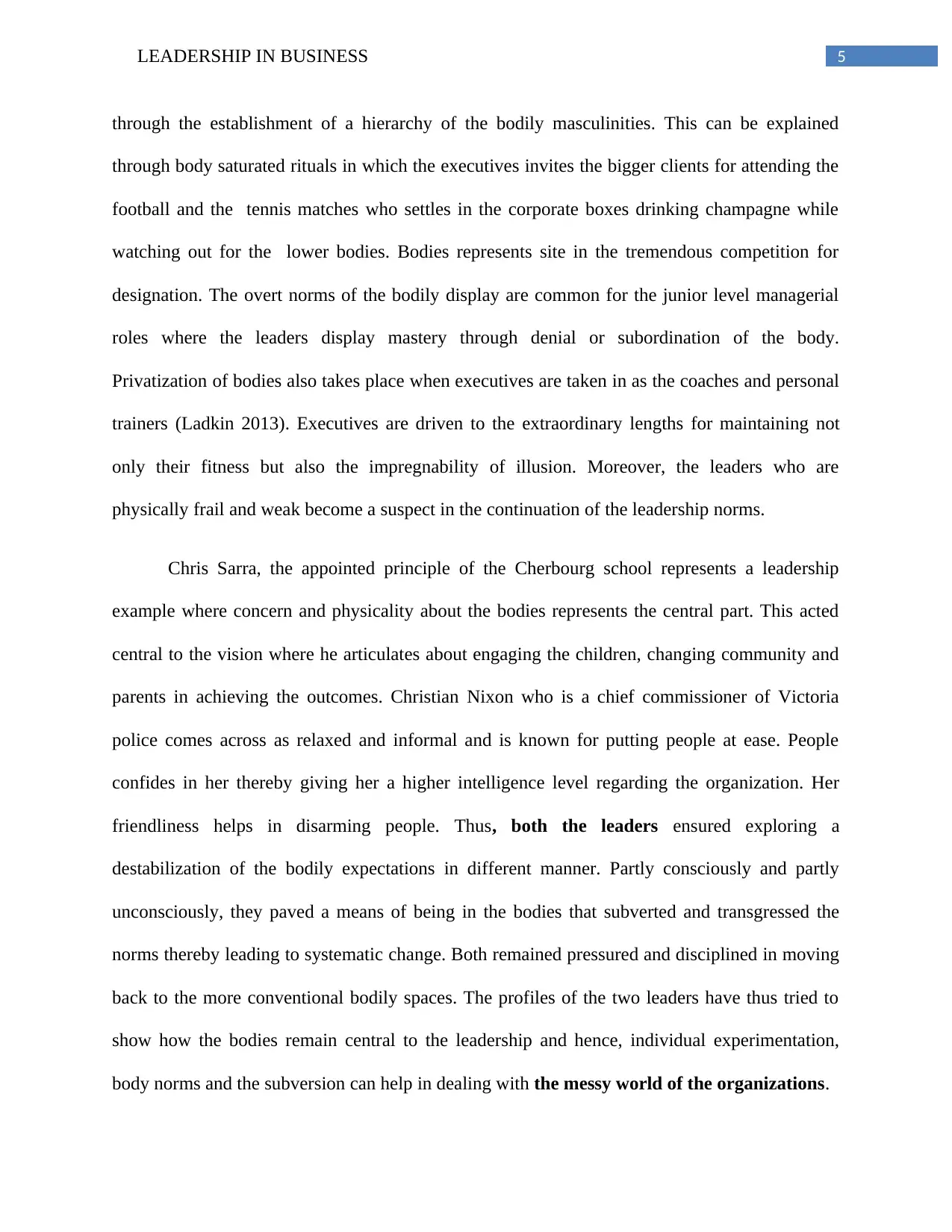
5LEADERSHIP IN BUSINESS
through the establishment of a hierarchy of the bodily masculinities. This can be explained
through body saturated rituals in which the executives invites the bigger clients for attending the
football and the tennis matches who settles in the corporate boxes drinking champagne while
watching out for the lower bodies. Bodies represents site in the tremendous competition for
designation. The overt norms of the bodily display are common for the junior level managerial
roles where the leaders display mastery through denial or subordination of the body.
Privatization of bodies also takes place when executives are taken in as the coaches and personal
trainers (Ladkin 2013). Executives are driven to the extraordinary lengths for maintaining not
only their fitness but also the impregnability of illusion. Moreover, the leaders who are
physically frail and weak become a suspect in the continuation of the leadership norms.
Chris Sarra, the appointed principle of the Cherbourg school represents a leadership
example where concern and physicality about the bodies represents the central part. This acted
central to the vision where he articulates about engaging the children, changing community and
parents in achieving the outcomes. Christian Nixon who is a chief commissioner of Victoria
police comes across as relaxed and informal and is known for putting people at ease. People
confides in her thereby giving her a higher intelligence level regarding the organization. Her
friendliness helps in disarming people. Thus, both the leaders ensured exploring a
destabilization of the bodily expectations in different manner. Partly consciously and partly
unconsciously, they paved a means of being in the bodies that subverted and transgressed the
norms thereby leading to systematic change. Both remained pressured and disciplined in moving
back to the more conventional bodily spaces. The profiles of the two leaders have thus tried to
show how the bodies remain central to the leadership and hence, individual experimentation,
body norms and the subversion can help in dealing with the messy world of the organizations.
through the establishment of a hierarchy of the bodily masculinities. This can be explained
through body saturated rituals in which the executives invites the bigger clients for attending the
football and the tennis matches who settles in the corporate boxes drinking champagne while
watching out for the lower bodies. Bodies represents site in the tremendous competition for
designation. The overt norms of the bodily display are common for the junior level managerial
roles where the leaders display mastery through denial or subordination of the body.
Privatization of bodies also takes place when executives are taken in as the coaches and personal
trainers (Ladkin 2013). Executives are driven to the extraordinary lengths for maintaining not
only their fitness but also the impregnability of illusion. Moreover, the leaders who are
physically frail and weak become a suspect in the continuation of the leadership norms.
Chris Sarra, the appointed principle of the Cherbourg school represents a leadership
example where concern and physicality about the bodies represents the central part. This acted
central to the vision where he articulates about engaging the children, changing community and
parents in achieving the outcomes. Christian Nixon who is a chief commissioner of Victoria
police comes across as relaxed and informal and is known for putting people at ease. People
confides in her thereby giving her a higher intelligence level regarding the organization. Her
friendliness helps in disarming people. Thus, both the leaders ensured exploring a
destabilization of the bodily expectations in different manner. Partly consciously and partly
unconsciously, they paved a means of being in the bodies that subverted and transgressed the
norms thereby leading to systematic change. Both remained pressured and disciplined in moving
back to the more conventional bodily spaces. The profiles of the two leaders have thus tried to
show how the bodies remain central to the leadership and hence, individual experimentation,
body norms and the subversion can help in dealing with the messy world of the organizations.
⊘ This is a preview!⊘
Do you want full access?
Subscribe today to unlock all pages.

Trusted by 1+ million students worldwide
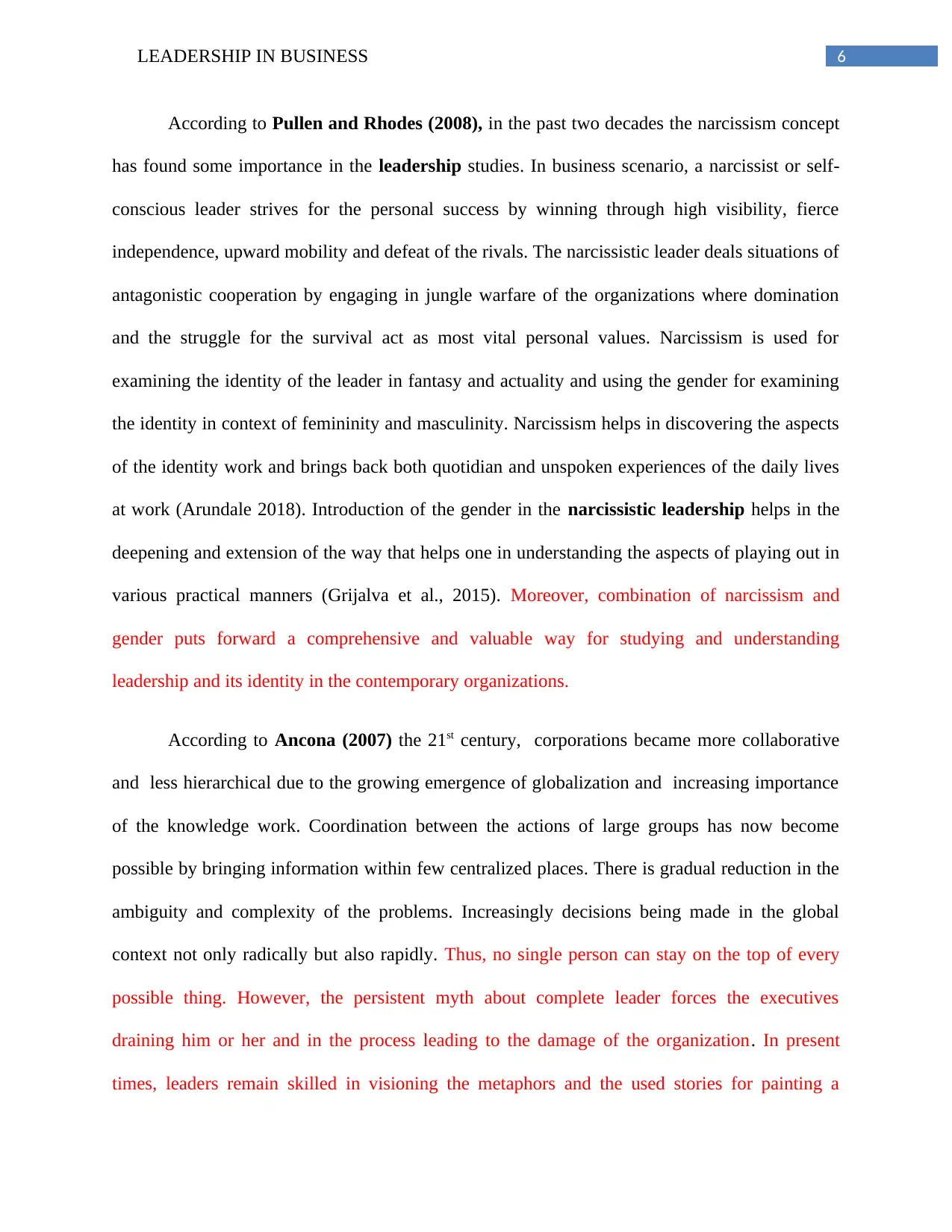
6LEADERSHIP IN BUSINESS
According to Pullen and Rhodes (2008), in the past two decades the narcissism concept
has found some importance in the leadership studies. In business scenario, a narcissist or self-
conscious leader strives for the personal success by winning through high visibility, fierce
independence, upward mobility and defeat of the rivals. The narcissistic leader deals situations of
antagonistic cooperation by engaging in jungle warfare of the organizations where domination
and the struggle for the survival act as most vital personal values. Narcissism is used for
examining the identity of the leader in fantasy and actuality and using the gender for examining
the identity in context of femininity and masculinity. Narcissism helps in discovering the aspects
of the identity work and brings back both quotidian and unspoken experiences of the daily lives
at work (Arundale 2018). Introduction of the gender in the narcissistic leadership helps in the
deepening and extension of the way that helps one in understanding the aspects of playing out in
various practical manners (Grijalva et al., 2015). Moreover, combination of narcissism and
gender puts forward a comprehensive and valuable way for studying and understanding
leadership and its identity in the contemporary organizations.
According to Ancona (2007) the 21st century, corporations became more collaborative
and less hierarchical due to the growing emergence of globalization and increasing importance
of the knowledge work. Coordination between the actions of large groups has now become
possible by bringing information within few centralized places. There is gradual reduction in the
ambiguity and complexity of the problems. Increasingly decisions being made in the global
context not only radically but also rapidly. Thus, no single person can stay on the top of every
possible thing. However, the persistent myth about complete leader forces the executives
draining him or her and in the process leading to the damage of the organization. In present
times, leaders remain skilled in visioning the metaphors and the used stories for painting a
According to Pullen and Rhodes (2008), in the past two decades the narcissism concept
has found some importance in the leadership studies. In business scenario, a narcissist or self-
conscious leader strives for the personal success by winning through high visibility, fierce
independence, upward mobility and defeat of the rivals. The narcissistic leader deals situations of
antagonistic cooperation by engaging in jungle warfare of the organizations where domination
and the struggle for the survival act as most vital personal values. Narcissism is used for
examining the identity of the leader in fantasy and actuality and using the gender for examining
the identity in context of femininity and masculinity. Narcissism helps in discovering the aspects
of the identity work and brings back both quotidian and unspoken experiences of the daily lives
at work (Arundale 2018). Introduction of the gender in the narcissistic leadership helps in the
deepening and extension of the way that helps one in understanding the aspects of playing out in
various practical manners (Grijalva et al., 2015). Moreover, combination of narcissism and
gender puts forward a comprehensive and valuable way for studying and understanding
leadership and its identity in the contemporary organizations.
According to Ancona (2007) the 21st century, corporations became more collaborative
and less hierarchical due to the growing emergence of globalization and increasing importance
of the knowledge work. Coordination between the actions of large groups has now become
possible by bringing information within few centralized places. There is gradual reduction in the
ambiguity and complexity of the problems. Increasingly decisions being made in the global
context not only radically but also rapidly. Thus, no single person can stay on the top of every
possible thing. However, the persistent myth about complete leader forces the executives
draining him or her and in the process leading to the damage of the organization. In present
times, leaders remain skilled in visioning the metaphors and the used stories for painting a
Paraphrase This Document
Need a fresh take? Get an instant paraphrase of this document with our AI Paraphraser
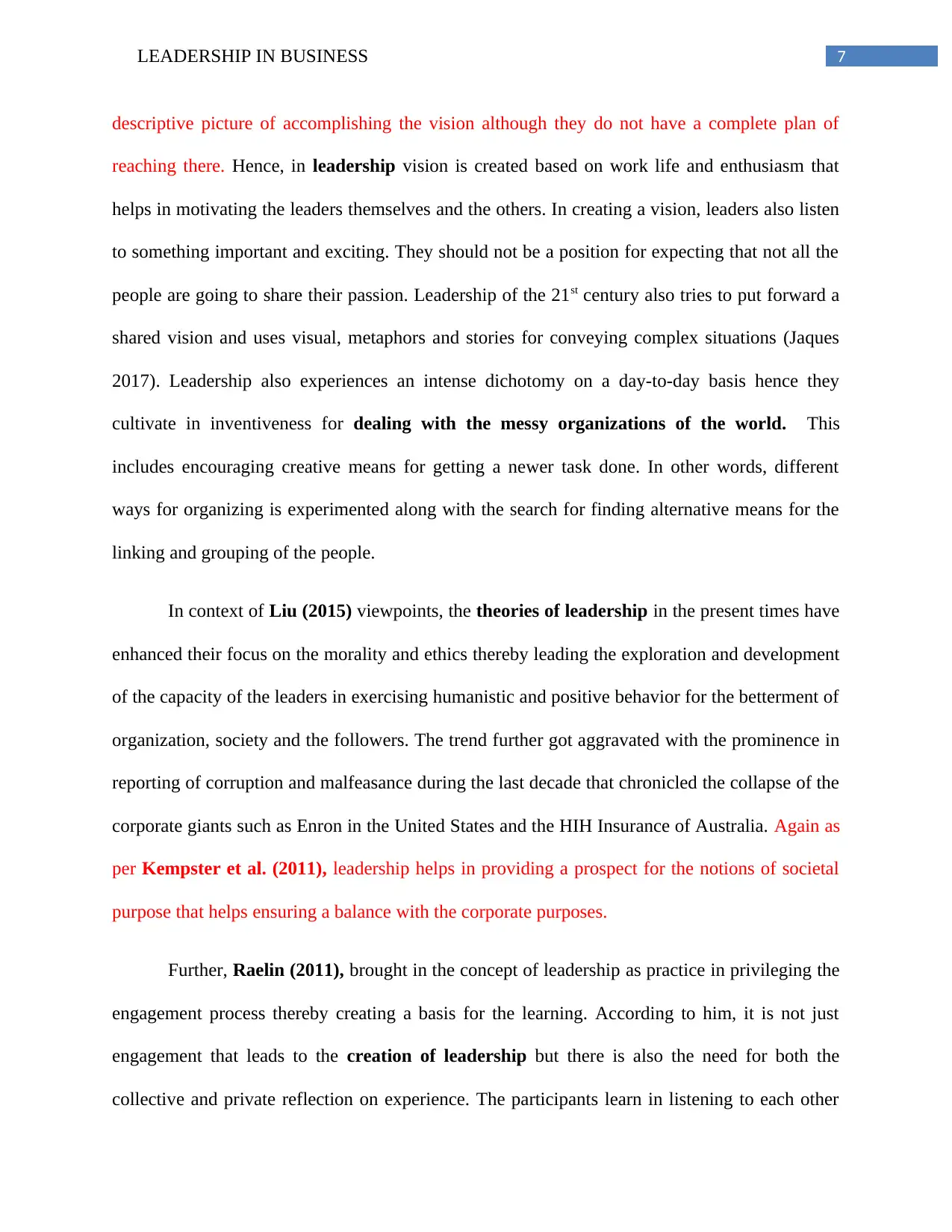
7LEADERSHIP IN BUSINESS
descriptive picture of accomplishing the vision although they do not have a complete plan of
reaching there. Hence, in leadership vision is created based on work life and enthusiasm that
helps in motivating the leaders themselves and the others. In creating a vision, leaders also listen
to something important and exciting. They should not be a position for expecting that not all the
people are going to share their passion. Leadership of the 21st century also tries to put forward a
shared vision and uses visual, metaphors and stories for conveying complex situations (Jaques
2017). Leadership also experiences an intense dichotomy on a day-to-day basis hence they
cultivate in inventiveness for dealing with the messy organizations of the world. This
includes encouraging creative means for getting a newer task done. In other words, different
ways for organizing is experimented along with the search for finding alternative means for the
linking and grouping of the people.
In context of Liu (2015) viewpoints, the theories of leadership in the present times have
enhanced their focus on the morality and ethics thereby leading the exploration and development
of the capacity of the leaders in exercising humanistic and positive behavior for the betterment of
organization, society and the followers. The trend further got aggravated with the prominence in
reporting of corruption and malfeasance during the last decade that chronicled the collapse of the
corporate giants such as Enron in the United States and the HIH Insurance of Australia. Again as
per Kempster et al. (2011), leadership helps in providing a prospect for the notions of societal
purpose that helps ensuring a balance with the corporate purposes.
Further, Raelin (2011), brought in the concept of leadership as practice in privileging the
engagement process thereby creating a basis for the learning. According to him, it is not just
engagement that leads to the creation of leadership but there is also the need for both the
collective and private reflection on experience. The participants learn in listening to each other
descriptive picture of accomplishing the vision although they do not have a complete plan of
reaching there. Hence, in leadership vision is created based on work life and enthusiasm that
helps in motivating the leaders themselves and the others. In creating a vision, leaders also listen
to something important and exciting. They should not be a position for expecting that not all the
people are going to share their passion. Leadership of the 21st century also tries to put forward a
shared vision and uses visual, metaphors and stories for conveying complex situations (Jaques
2017). Leadership also experiences an intense dichotomy on a day-to-day basis hence they
cultivate in inventiveness for dealing with the messy organizations of the world. This
includes encouraging creative means for getting a newer task done. In other words, different
ways for organizing is experimented along with the search for finding alternative means for the
linking and grouping of the people.
In context of Liu (2015) viewpoints, the theories of leadership in the present times have
enhanced their focus on the morality and ethics thereby leading the exploration and development
of the capacity of the leaders in exercising humanistic and positive behavior for the betterment of
organization, society and the followers. The trend further got aggravated with the prominence in
reporting of corruption and malfeasance during the last decade that chronicled the collapse of the
corporate giants such as Enron in the United States and the HIH Insurance of Australia. Again as
per Kempster et al. (2011), leadership helps in providing a prospect for the notions of societal
purpose that helps ensuring a balance with the corporate purposes.
Further, Raelin (2011), brought in the concept of leadership as practice in privileging the
engagement process thereby creating a basis for the learning. According to him, it is not just
engagement that leads to the creation of leadership but there is also the need for both the
collective and private reflection on experience. The participants learn in listening to each other
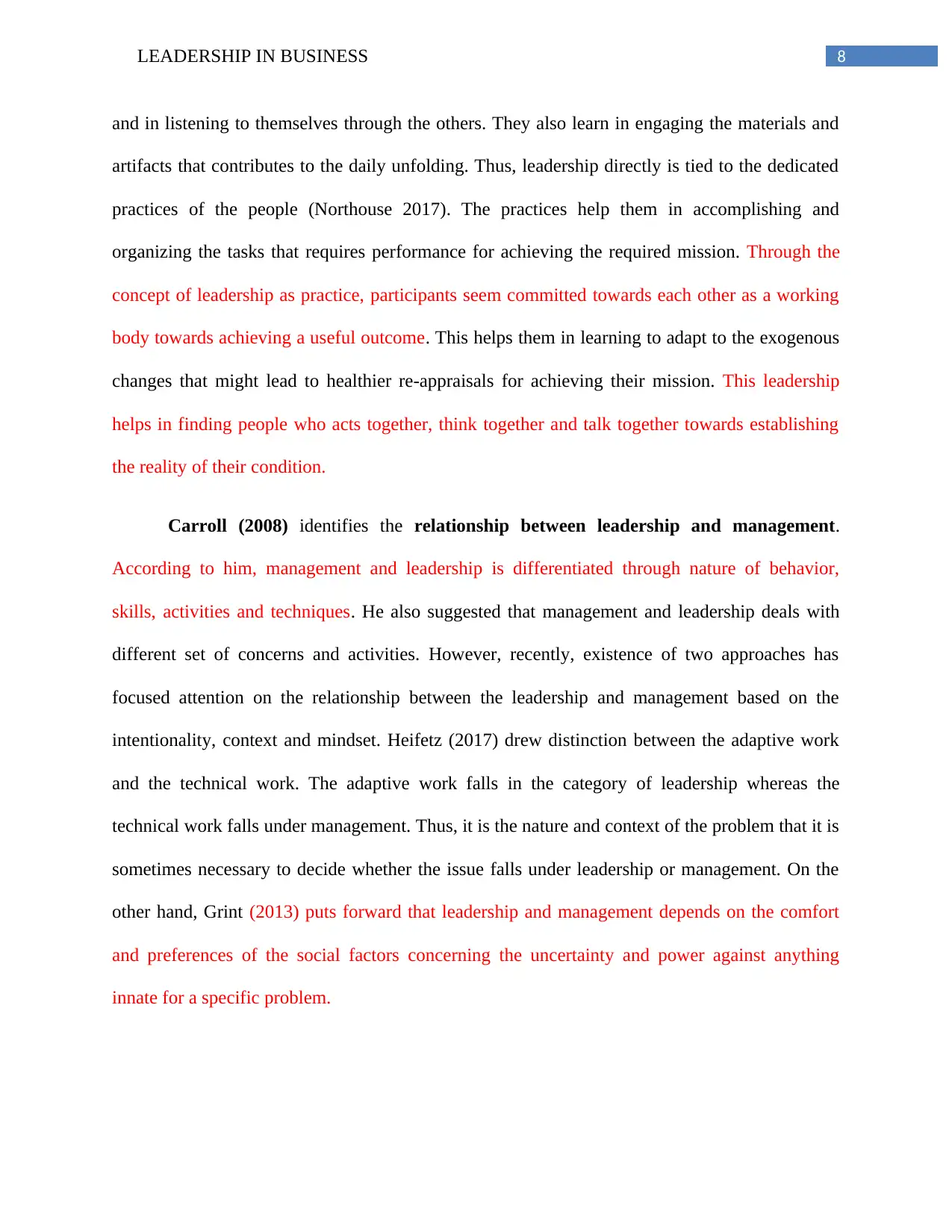
8LEADERSHIP IN BUSINESS
and in listening to themselves through the others. They also learn in engaging the materials and
artifacts that contributes to the daily unfolding. Thus, leadership directly is tied to the dedicated
practices of the people (Northouse 2017). The practices help them in accomplishing and
organizing the tasks that requires performance for achieving the required mission. Through the
concept of leadership as practice, participants seem committed towards each other as a working
body towards achieving a useful outcome. This helps them in learning to adapt to the exogenous
changes that might lead to healthier re-appraisals for achieving their mission. This leadership
helps in finding people who acts together, think together and talk together towards establishing
the reality of their condition.
Carroll (2008) identifies the relationship between leadership and management.
According to him, management and leadership is differentiated through nature of behavior,
skills, activities and techniques. He also suggested that management and leadership deals with
different set of concerns and activities. However, recently, existence of two approaches has
focused attention on the relationship between the leadership and management based on the
intentionality, context and mindset. Heifetz (2017) drew distinction between the adaptive work
and the technical work. The adaptive work falls in the category of leadership whereas the
technical work falls under management. Thus, it is the nature and context of the problem that it is
sometimes necessary to decide whether the issue falls under leadership or management. On the
other hand, Grint (2013) puts forward that leadership and management depends on the comfort
and preferences of the social factors concerning the uncertainty and power against anything
innate for a specific problem.
and in listening to themselves through the others. They also learn in engaging the materials and
artifacts that contributes to the daily unfolding. Thus, leadership directly is tied to the dedicated
practices of the people (Northouse 2017). The practices help them in accomplishing and
organizing the tasks that requires performance for achieving the required mission. Through the
concept of leadership as practice, participants seem committed towards each other as a working
body towards achieving a useful outcome. This helps them in learning to adapt to the exogenous
changes that might lead to healthier re-appraisals for achieving their mission. This leadership
helps in finding people who acts together, think together and talk together towards establishing
the reality of their condition.
Carroll (2008) identifies the relationship between leadership and management.
According to him, management and leadership is differentiated through nature of behavior,
skills, activities and techniques. He also suggested that management and leadership deals with
different set of concerns and activities. However, recently, existence of two approaches has
focused attention on the relationship between the leadership and management based on the
intentionality, context and mindset. Heifetz (2017) drew distinction between the adaptive work
and the technical work. The adaptive work falls in the category of leadership whereas the
technical work falls under management. Thus, it is the nature and context of the problem that it is
sometimes necessary to decide whether the issue falls under leadership or management. On the
other hand, Grint (2013) puts forward that leadership and management depends on the comfort
and preferences of the social factors concerning the uncertainty and power against anything
innate for a specific problem.
⊘ This is a preview!⊘
Do you want full access?
Subscribe today to unlock all pages.

Trusted by 1+ million students worldwide
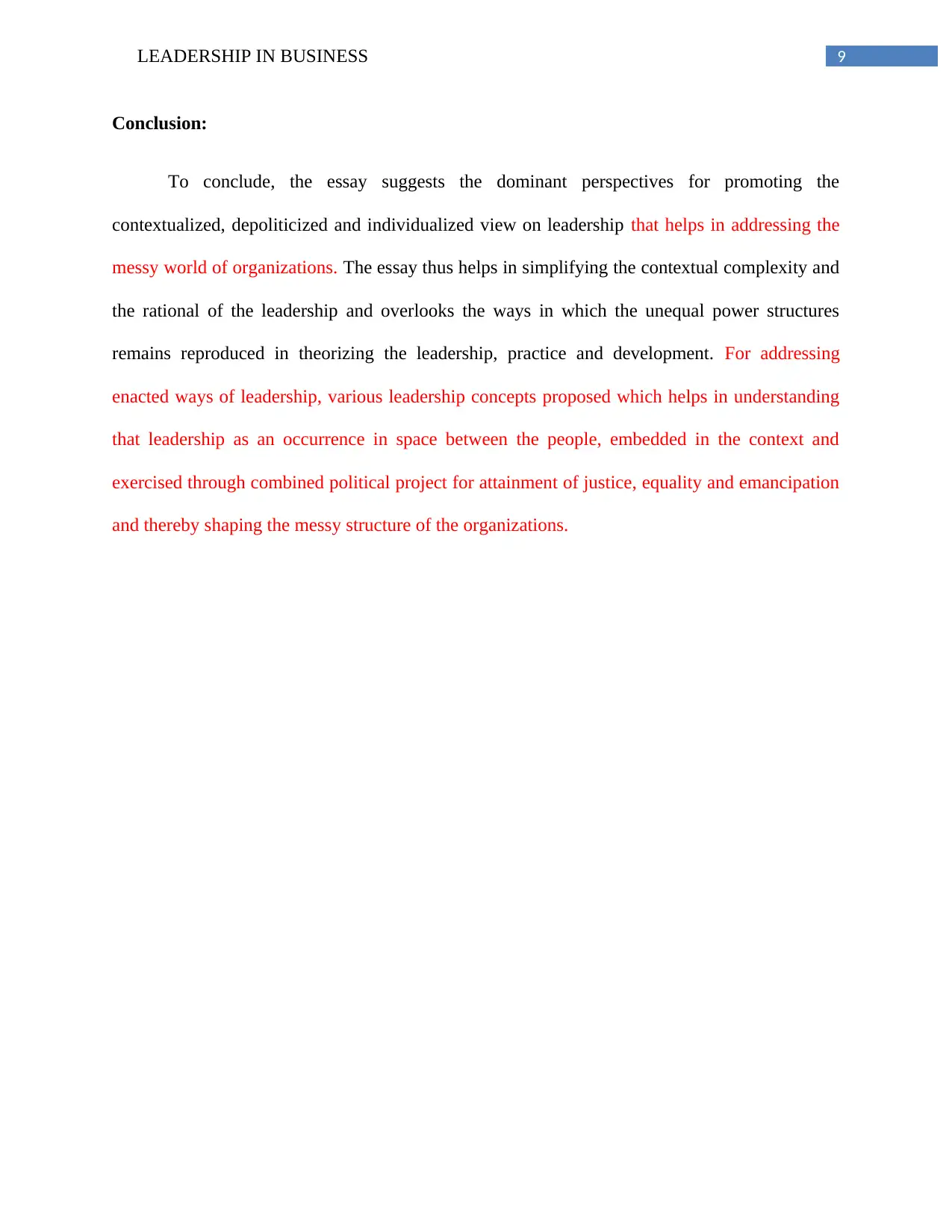
9LEADERSHIP IN BUSINESS
Conclusion:
To conclude, the essay suggests the dominant perspectives for promoting the
contextualized, depoliticized and individualized view on leadership that helps in addressing the
messy world of organizations. The essay thus helps in simplifying the contextual complexity and
the rational of the leadership and overlooks the ways in which the unequal power structures
remains reproduced in theorizing the leadership, practice and development. For addressing
enacted ways of leadership, various leadership concepts proposed which helps in understanding
that leadership as an occurrence in space between the people, embedded in the context and
exercised through combined political project for attainment of justice, equality and emancipation
and thereby shaping the messy structure of the organizations.
Conclusion:
To conclude, the essay suggests the dominant perspectives for promoting the
contextualized, depoliticized and individualized view on leadership that helps in addressing the
messy world of organizations. The essay thus helps in simplifying the contextual complexity and
the rational of the leadership and overlooks the ways in which the unequal power structures
remains reproduced in theorizing the leadership, practice and development. For addressing
enacted ways of leadership, various leadership concepts proposed which helps in understanding
that leadership as an occurrence in space between the people, embedded in the context and
exercised through combined political project for attainment of justice, equality and emancipation
and thereby shaping the messy structure of the organizations.
Paraphrase This Document
Need a fresh take? Get an instant paraphrase of this document with our AI Paraphraser
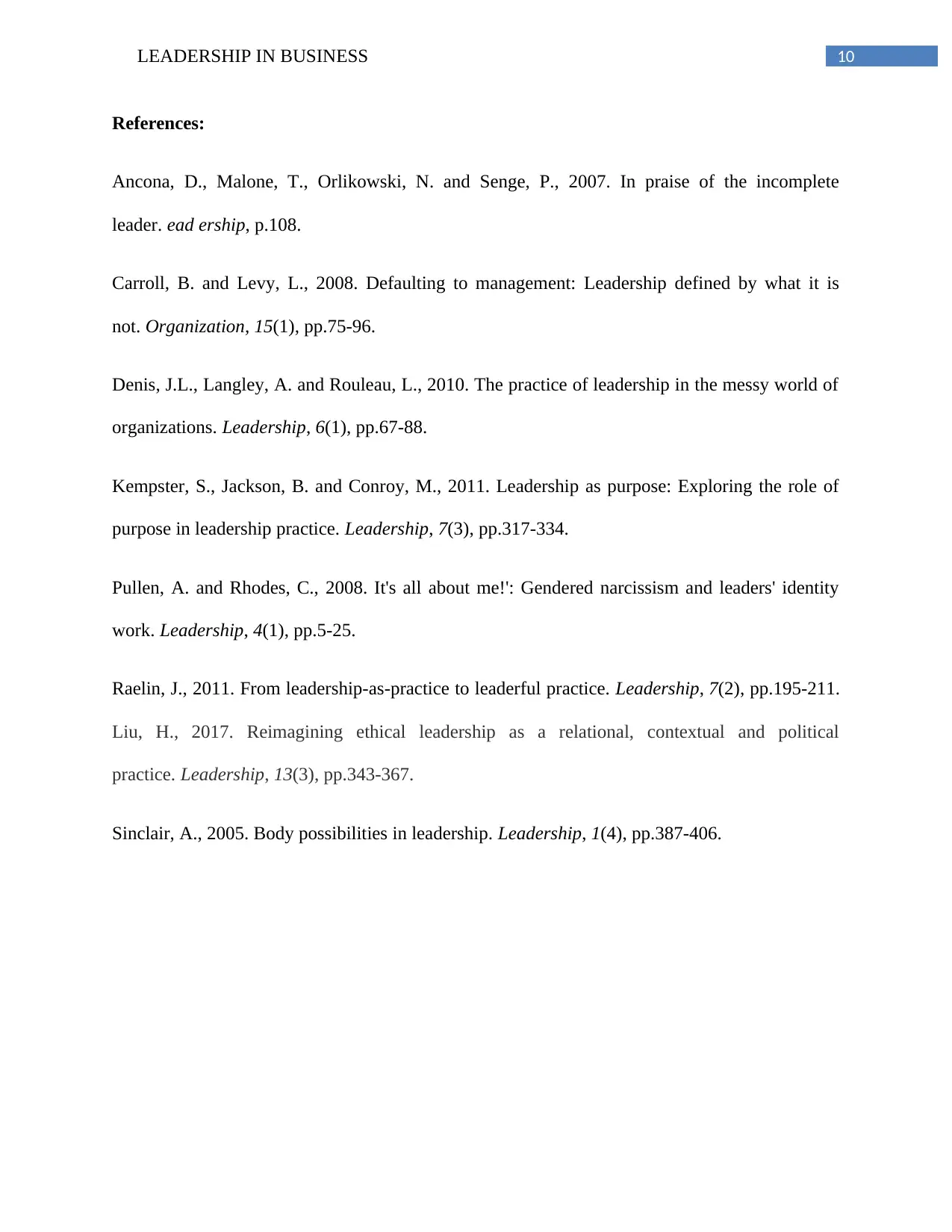
10LEADERSHIP IN BUSINESS
References:
Ancona, D., Malone, T., Orlikowski, N. and Senge, P., 2007. In praise of the incomplete
leader. ead ership, p.108.
Carroll, B. and Levy, L., 2008. Defaulting to management: Leadership defined by what it is
not. Organization, 15(1), pp.75-96.
Denis, J.L., Langley, A. and Rouleau, L., 2010. The practice of leadership in the messy world of
organizations. Leadership, 6(1), pp.67-88.
Kempster, S., Jackson, B. and Conroy, M., 2011. Leadership as purpose: Exploring the role of
purpose in leadership practice. Leadership, 7(3), pp.317-334.
Pullen, A. and Rhodes, C., 2008. It's all about me!': Gendered narcissism and leaders' identity
work. Leadership, 4(1), pp.5-25.
Raelin, J., 2011. From leadership-as-practice to leaderful practice. Leadership, 7(2), pp.195-211.
Liu, H., 2017. Reimagining ethical leadership as a relational, contextual and political
practice. Leadership, 13(3), pp.343-367.
Sinclair, A., 2005. Body possibilities in leadership. Leadership, 1(4), pp.387-406.
References:
Ancona, D., Malone, T., Orlikowski, N. and Senge, P., 2007. In praise of the incomplete
leader. ead ership, p.108.
Carroll, B. and Levy, L., 2008. Defaulting to management: Leadership defined by what it is
not. Organization, 15(1), pp.75-96.
Denis, J.L., Langley, A. and Rouleau, L., 2010. The practice of leadership in the messy world of
organizations. Leadership, 6(1), pp.67-88.
Kempster, S., Jackson, B. and Conroy, M., 2011. Leadership as purpose: Exploring the role of
purpose in leadership practice. Leadership, 7(3), pp.317-334.
Pullen, A. and Rhodes, C., 2008. It's all about me!': Gendered narcissism and leaders' identity
work. Leadership, 4(1), pp.5-25.
Raelin, J., 2011. From leadership-as-practice to leaderful practice. Leadership, 7(2), pp.195-211.
Liu, H., 2017. Reimagining ethical leadership as a relational, contextual and political
practice. Leadership, 13(3), pp.343-367.
Sinclair, A., 2005. Body possibilities in leadership. Leadership, 1(4), pp.387-406.
1 out of 11
Your All-in-One AI-Powered Toolkit for Academic Success.
+13062052269
info@desklib.com
Available 24*7 on WhatsApp / Email
![[object Object]](/_next/static/media/star-bottom.7253800d.svg)
Unlock your academic potential
Copyright © 2020–2025 A2Z Services. All Rights Reserved. Developed and managed by ZUCOL.
